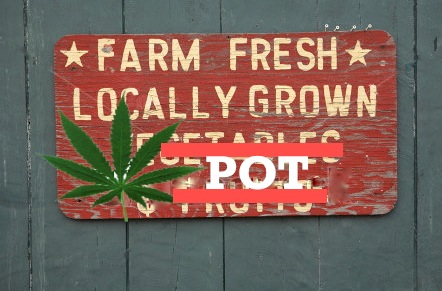Have you Visited the Pot Farmer’s Market in Sonoma?
The article below was first posted on ModernFarmer.com
Scenes From a Pot Farmers’ Market
In Sonoma, California you can go green with outdoor pot grown locally, sustainably, in small batches
By David Downs on April 11, 2013
Illustration by Marina Luz
Northern California’s first pot farmers’ market is like most other farmers’ markets, except you buy weed instead of kale and there’s the possibility you’ll go to prison – which gives visits to theOrganicann Harvest Market in Sonoma County a bit of an edge this chilly morning.
Driving through Sonoma’s famed pastures and rolling vineyards, I note billboards advertising casinos and hydroponics—a favored tool for cultivating pot indoors. This is pot country as much as wine country. Marijuana is the second most-popular intoxicant in the world (after alcohol) and largely legal in the Golden State thanks to 1996 and 2003 laws that allow its use for medicinal purposes.
But ongoing federal and local raids, and hefty prison sentences for store operators are real enough to make a shopper nervous.
The bazaar operates out of a hulking, purple warehouse set back on an asphalt parking lot in an industrial zone of unincorporated Sonoma County. Still federally illegal, of course, such markets are legal under California state law, provided vendors and customers join a collective with a valid doctor’s recommendation for pot and a state ID – a free process that takes about 15 minutes.
In emails, the club crows that their third-Saturday-of-the-month markets have become “wildly successful.” Indeed, by 1 p.m. on a January afternoon, a crowd is queuing up to get inside the third such event. The market dress code is country-weathered and swap-meet casual and a quick scan locates pot heavyweights like Rick Pfrommer – bud buyer for the biggest pot club on the planet, Harborside Health Center of Oakland and Wilson Linker, general manager of the pioneering Steep Hill cannabis lab in Oakland.
It turns out that the draw for a pot farmer’s market isn’t so different from a traditional one. Linker says the market “embodies the spirit of [California’s medical marijuana laws] by directly connecting the patient and caregiver.”
But the security is certainly tighter. Bouncers warn everyone that there are no bags, cell phone use, or smoking of any kind allowed and then let customers into a bright, freezing warehouse bustling with the din of a busy bazaar. Old school reggae pounds out of loudspeakers. Vendors show off their wares on card tables, and the crowd slowly rotates around the stations, examining the produce, stamping and hugging themselves for warmth.
California pot farmers’ markets were just a matter of time, says Dominic Corva, a public policy analyst from Sarah Lawrence College in New York who researched Humboldt County’s weed market for three years.
“The passage of medical marijuana initiatives in combination with increasing public acceptance and careful coordination with local municipal authorities has led to an environment where cannabis, as an agricultural resource, is permitted to circulate the way other agricultural commodities are,” he said.
‘Sungrown cannabis is going to continue to claim a larger and larger share of the market,’ says Harborside Health Center founder Steve DeAngelo.
Organicann has blazed a prominent trail in Sonoma, obtaining the first dispensary permit issued by the county, and growing to four locations in Oakland, San Diego, Sausalito and their flagship storefront near Santa Rosa. Studies indicate Organicann grosses perhaps tens of millions of dollars annually, but they don’t do press, and their books are private. But they are not first to organize pot markets: as Corva notes, a similar indoor bud market has existed in Tacoma, Washington since 2010. Scattered reports indicate sporadic markets have also been held elsewhere in California and Washington as well as in Arizona– all symptoms of the normalization of the commodity, he said.
And part of that normalization includes a new demand for pot grown locally, sustainably, in small batches, outdoors, and rather cheaply; a key draw at the Organicann Market. “Sungrown” or outdoor marijuana, is making something of a comeback in California’s medical scene, watchers say.
Indoor-grown pot has dominated stores for about a decade, because it tends to be more potent, pretty, and fragrant, while outdoor weed is reputedly weaker, weathered and less pungent. But outdoor growers and certain dispensaries have rebranded it, offering “sungrown” cuts that compete with indoor, if not on looks, then on price, potency and carbon footprint.
“Sungrown cannabis is going to continue to claim a larger and larger share of the market,” saysHarborside Health Center founder Steve DeAngelo.
Up to 90 percent of pot’s cost isn’t flowering time or vendor reputation – it’s the drug’s “risk premium,” RAND Drug Policy Researcher Center staff have found. As risk goes down, more growers enter the market, and prices tumble. Outdoor costs much less to grow than indoor, and ounces of it sell at a maximum of $250 at the Harvest Market, versus indoor ounces which start at $280 and can go as high as $360.
By far, the best deal of the day is $25 for a six-sample flight of strains, mixed and matched by the gram from the dozens on display. Six grams can run $80 in a club.
As for the crowd, it is surprisingly diverse. Aging grandmas with short gray hair and faded North Face fleece rub elbows with retired cowboys. Twenty-something girls in Ugg boots and black tights hock Bhang medicated chocolate bars at a side booth. Plaid-clad stoners sell concentrated cannabis called “butane hash oil” in little vials. An elderly hippie couple sells “medicated” hard candy. Some customers use wheelchairs, more have canes.
Most shoppers opt for the $25 flight package, which comes with six carnival tickets and a strip of small plastic containers. Everyone takes turns at each booth examining the produce. In exchange for a carnival ticket, the vendor mashes a gram of pot into one of the six mini-containers, snaps it shut and labels it.
Growers at the Harvest Market seem like hobbyists of varying skill selling home-grown strains unfit for purchase by clubs. The majority of these folks will go home with more money than they showed up with, but there’s a tension to their sales pitches, as if they aren’t getting much business, and half of all the proceeds reportedly go to charity. Rural California remains weakened by the Great Recession, and medical bud growing has become a sideline business for the desperate and risk-tolerant, insiders say. But most produce simply can’t match Organicann’s official wares.
For now, pot farmers’ markets appear to be a place to score lots of cheap, middling product—the bulk bin shopping of the pot world.
But, like at any farmers’ markets, there are stand-out vendors. Today, it’s a late-50ish white guy wearing a smile and latex gloves, who mans a table covered in plastic bins full of almost a dozen strains.
The fragrant, resin-filled flower tops of the cannabis plant are what users smoke, and this guy waves his huge flower tops around while grinning. One lumpy, pale green stick is as thick as a child’s arm—his outdoor grown Blue Dream, he says. A thick hub of people politely vye to get closer to his table.
Outdoor growers can specialize in rare, giant sativas that take too long to flower and grow too big to be economical indoors. This guy doesn’t disappoint, offering rare sativas like Pineapple Thai and a Super Mango he said reached 15 feet tall.
His cuts are extra-pungent, which indicates potency, and completely flocked in microscopic trichomes — shiny, translucent, external plant glands filled with weed’s main psychoactive ingredient, Delta-9-Tetrahydrocannabinol.
The grower won’t give his name, but says he works outdoors in the Humboldt hills (“about mid-mountain”) and the 2012 growing season was simply one of the best in memory – hot, dry, and long.
Maybe it’s a contact high, or maybe because it’s just lunchtime, but I suddenly realize I’m starving. Looking around, there aren’t any snacks without weed in them, so I make for the exit while quizzing my iPhone about the nearest barbecue. If there’s one thing still missing from the brave new world of a NorCal weed farmers’ market – it’s a fleet of gourmet food trucks.
Source: http://modernfarmer.com/2013/04/scenes-from-a-pot-farmers-market/
About Rebecca Valverde
LA rocker chick, songwriter, and shopping fanatic, Rebecca has been smoking green since she can remember! Like most musicians, she feels cannabis is an essential part of her songwriting career and she loves visiting the 20+ different dispensaries in her LA neighborhood and trying different strains. Rebecca is responsible for finding awesome and informative videos for the 420Cali.com community.
Related posts
-
What is a Medical Marijuana Doctor by ...
June 11, 2013
-
Faded Fridays – What would you do ...
June 7, 2013
-
Ex-Microsoft exec plans to build the ‘Starbucks’ ...
June 3, 2013
-
Assembly bill in California to regulate medical ...
June 2, 2013











